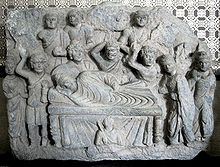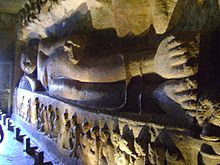- Parinirvana
-
In Buddhism, parinirvana (Sanskrit: परिनिर्वाण parinirvāṇa; Pali: परिनिब्बाण parinibbāṇa; Chinese: 般涅槃, bō niè pán) is the final nirvana, which occurs upon the death of the body of someone who has attained complete awakening (bodhi). It implies a release from the bhavachakra, Saṃsāra, karma and rebirth as well as the dissolution of the skandhas.
The parinibbana of the [Buddha] is described in the Mahāparinibbāna sutta. Because of its attention to detail, the Mahaparinibbana Sutta (of the Theravada tradition), though first committed to writing hundreds of years after his death, has been resorted to as the principal source of reference in most standard studies of the Buddha's life.[1]
In some Mahayana scriptures (notably the Mahayana Mahaparinirvana Sutra), Parinirvana is explicated as the realm of the eternal true Self of the Buddha.
Contents
Accounts
Accounts of the purported events surrounding the Buddha's own parinirvāṇa are found in a wide range of Buddhist canonical literature. In addition to the Pāli Mahāparinibbāna sutta and its Sanskrit parallels, the topic is treated in the Saṃyutta-nikāya (6.2.5) and the several Sanskrit parallels (T99 p253c-254c), the Sanskrit-based Ekottara-āgama (T125 p750c), and other early sutras preserved in Chinese, as well as in most of the Vinayas preserved in Chinese of the early Buddhist schools such as the Sarvāstivādins and the Mahāsāṅghikas. The historical event of the Buddha's parinirvāṇa is also described in a number of later works, such as the Sanskrit Buddha-carita and the Avadāna-śataka, and the Pāli Mahāvaṃsa.
According to Bareau, the oldest core components of all these accounts are just the account of the Buddha's parinirvāṇa itself at Kuśinagara and the funerary rites following his death.[2] He deems all other extended details to be later additions with little historical value.
In contrast to these works which deal with the Buddha's parinirvāṇa as a biographical event, the Mahāyāna Mahāparinirvāṇa Mahā-sūtra, which bears a similar name, was written hundreds of years later.[3] The Nirvana Sutra does not give details of the historical event of the day of the parinirvāṇa itself, except the Buddha's illness and Cunda's meal offering, nor any of the other preceding or subsequent incidents, instead using the event as merely a convenient springboard[weasel words] for the expression of standard Mahayana ideals such as the tathagata-garbha / buddha-dhatu doctrine, the eternality of the Buddha, and the soteriological fate of the icchantikas and so forth.[4]
In Mahayana literature
 Attendants to the Parinirvana, Gandhara, Victoria and Albert museum
Attendants to the Parinirvana, Gandhara, Victoria and Albert museum
According to the Mahayana Mahaparinirvana Mahā-sūtra (also called the Nirvana Sutra), the Buddha taught that parinirvana is the realm of the Eternal, Bliss, the Self, and the Pure. Dr. Paul Williams states that it depicts the Buddha using the term "Self" in order to win over non-Buddhist ascetics.[5] However, the Mahaparinirvana Sutra is a long and highly composite Mahayana scripture,[6] and the part of the sutra upon which Williams is basing his statement is a portion of the Nirvana Sutra of secondary Central Asian provenance - other parts of the sutra were written in India.[7]
Guang Xing speaks of how the Mahayanists of the Nirvana Sutra understand the mahaparinirvana to be the liberated Self of the eternal Buddha:[8]
One of the main themes of the MMPS [Mahayana Mahaparinirvana Sutra] is that the Buddha is eternal ... The Mahayanists assert the eternity of the Buddha in two ways in the MMPS. They state that the Buddha is the dharmakaya, and hence eternal. Next, they reinterpret the liberation of the Buddha as mahaparinirvana possessing four attributes: eternity, happiness, self and purity.Only in Mahaparinirvana is this True Self held to be fully discernible and accessible.[9]
Kosho Yamamoto cites a passage in which the Buddha admonishes his monks not to dwell inordinately on the idea of the non-Self but to meditate on the Self. Dr. Yamamoto writes:[10]
Having dwelt upon the nature of nirvana, the Buddha now explains its positive aspect and says that nirvana has the four attributes of the Eternal, Bliss, the Self, and the Pure ... the Buddha says: "O you bhiksus [monks]! Do not abide in the thought of the non-eternal, sorrow, non-Self, and the not-pure and have things as in the case of those people who take the stones, wooden pieces and gravel for the true gem [of the true Dharma] ... In every situation, constantly meditate upon the idea of the Self, the idea of the Eternal, Bliss, and the Pure ... Those who, desirous of attaining Reality meditatively cultivate these ideas, namely, the ideas of the Self [atman], the Eternal, Bliss, and the Pure, will skilfully bring forth the jewel, just like the wise person."Michael Zimmermann, in his study of the Tathagatagarbha Sutra, reveals that not only the Mahaparinirvana Sutra but also the Tathagatagarbha Sutra and the Lankavatara Sutra speak affirmatively of the Self. Zimmermann observes:[11]
the existence of an eternal, imperishable self, that is, buddhahood, is definitely the basic point of the TGS [Tathagatagarbha Sutra] ... the Mahaparinirvanasutra and the Lankavatarasutra characterize the tathagatagarbha explicitly as atman [Self].See also
Notes
- ^ Buddhism: Critical Concepts in Religious Studies, Paul Williams, Published by Taylor & Francis, 2005. page 190
- ^ Bareau, Andrė: "La composition et les ėtapes de la formation progressive du Mahāparinirvāṇasūtra ancien, BEFEO 66, pp45-103
- ^ The Mahaparinibbana Sutta is pre-Ashokan; see Juliane Schober, Sacred biography in the Buddhist traditions of South and Southeast Asia. University of Hawaii Press, 1997, page 171, while the Mahayana text dates to the second century CE or later: see Shimoda, Masahiro: A Study of the Mahāparinivāṇasūtra ~ with a Focus on the Methodology of the Study of Mahāyāna Sūtras, Shunjū-sha (1997) pp446-48.
- ^ "The Doctrine of Buddha-nature in the Mahayana Mahaparinirvana Sutra", by Ming-Wood Liu, in: Buddhism: Yogācāra, the epistemological tradition and Tathāgatagarbha. Paul Williams, Published by Taylor & Francis, 2005. page 190
- ^ Paul Williams, Mahāyāna Buddhism: The Doctrinal Foundations.Taylor & Francis, 1989, page 100. "... it refers to the Buddha using the term "Self" in order to win over non-Buddhist ascetics."
- ^ Paul Williams, Mahāyāna Buddhism: The Doctrinal Foundations.Taylor & Francis, 1989, page 98, see also page 99.
- ^ Williams quotes Ruegg "La Traitė du Tathāgatagarbha de Bu Ston Rin Chen Grub" pp113-144, where the reference for this passage is given as Taisho 0525a12-b02 of the Dharmakṣema translation. The entire Dharmakṣema translation is found at Taisho 0365c06-0603c26. The first 10 juan which scholars unanimously accept as Indic in origin occupies just Taisho 0365c06-0428b20, while the remaining portion from 428b24-0603c26 is deemed by all scholars to be of Central Asian origin. See Mahāyāna-Mahāparinirvāṇa Mahā-sūtra, subsection "Transmission & Authenticity" for details of scholarly opinions of textual structure with references.
- ^ Dr. Guang Xing, The Concept of the Buddha: Its Evolution from Early Buddhism to the Trikaya, RoutledgeCurzon, Oxford, 2005, p. 89
- ^ Kosho Yamamoto, Mahayanism: A Critical Exposition of the Mahayana Mahaparinirvana Sutra, Karin Bunko, Tokyo, 1975, p.62
- ^ Kosho Yamamoto, Mahayanism: A Critical Exposition of the Mahayana Mahaparinirvana Sutra, the Karinbunko, Tokyo, 1975, p. 75
- ^ Professor Michael Zimmermann, A Buddha Within: The Tathāgatagarbhasūtra, Biblotheca Philologica et Philosophica Buddhica VI, The International Research Institute for Advanced Buddhology, Soka University (2002) pp. 82 – 83
External links
- Complete translation of the Mahayana Mahaparinirvana Sutra
- SN VI.15: Parinibbana Sutta - Total Unbinding
- Maha-parinibbana Sutta - The Great Discourse on the Total Unbinding
- Article in The New York Times Buddha in Nirvana
Buddhism Buddhism portal Categories:- Sanskrit words and phrases
- Buddhist philosophical concepts
- Buddhist terms
- Gautama Buddha
Wikimedia Foundation. 2010.


